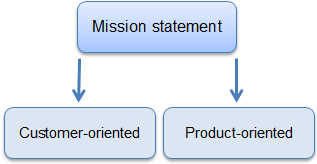Definition
Mission statement is a description of what an organization actually does – what its business is – and why it does it.[1]
See also: Purpose Statement
What is a Mission Statement
Often called the “credo”, “philosophy”, “core values” or “our aspirations”, organization’s mission is the statement that defines its core purpose or reason for being. [2] It tells who a company is and what it does.
According to P. Drucker, often called the father of modern management, a mission is the primary guidance in creating plans, strategies or making daily decisions. It is an important communication tool that conveys information about an organization’s products, services, targeted customers, geographic markets, philosophies, values and plans for future growth to all of its stakeholders.
In other words, every major reason why a company exists must be reflected in its mission, so that any employee, supplier, customer or community would understand the driving force behind organization’s operations.
There are two types of statements:[1]

- Customer-oriented missions. Customer-oriented missions define organization’s purpose in terms of meeting customer needs or providing solutions for them. They provide more flexibility than product-oriented missions and can be easily adapted to changing environment. For example, Nokia’s statement “connecting people” is customer-oriented. It does not focus on mobile phones or smartphones only. It provides a solution to customer needs and could easily have worked 50 years ago, and will continue to work in the future. It also gives more strategic flexibility for the company. In Nokia’s case, it may start providing VoIP software to allow calls to be made over the internet and its mission would still be valid.
- Product-oriented missions. Product-oriented missions focus on what products or services to serve rather than what solutions to provide for customers. These statements provide less flexibility for the company because most products have short life cycle and offer limited market expansion. The company that defines its business as “providing best health insurance products” may struggle to grow to other insurance product categories.
For a mission to be effective, it must include the following 9 components:[2]
- Customers. Who are your customers? How do you benefit them?
- Products or services. What are the main products or services that you offer? Their uniqueness?
- Markets. In which geographical markets do you operate?
- Technology. What is the firm’s basic technology?
- Concern for survival. Is the firm committed to growth and financial soundness?
- Philosophy. What are the basic beliefs, values and philosophies that guide an organization?
- Self-concept. What are the firm’s strengths, competencies or competitive advantages?
- Concern for public image. Is the firm socially responsible and environmentally friendly?
- Concern for employees. How does a company treat its employees?
Why creating a mission is important?
Many studies have been conducted to find out if having and communicating a mission statement helps an organization to achieve higher performance.[3]
The results were mixed. Some studies found a positive relationship between written statements and higher organizational performance, while other studies found none or even a negative relationship.
One of the reasons might be that most companies create a mission statement only because it’s fashionable to do so and little effort is made to actually communicate that mission to its stakeholders.
David[2] argues that if an organization constantly revises its mission and treats it as a living document, it achieves higher performance than its competitors. Nonetheless, all of the authors agree that mission brings the following benefits[3][4]:
- Informs the organization’s stakeholders about its plans and goals.
- Unifies employees’ efforts in pursuing company goals.
- Serves as an effective public relations tool.
- Provides a basis for allocating resources.
- Guides strategic or daily decision-making.
- Shows that a company is proactive.
Writing a mission
Creating a mission statement is an important first step in clearly identifying your business’ reason for being. It’s hard to do it right. Therefore, we identified these steps and guidelines to help you write an effective statement.
Step 1. Gather a team of managers, employees and shareholders. Mission is the statement that must be understood by employees of all levels. Involving more people will let you find out how each of them sees an organization and its core purpose. In addition, employees will support the organization’s mission more if they are involved in the process of creating it.
Step 2. Answer all 9 questions for an effective mission. Many practitioners and academics agree that a comprehensive statement must include all 9 components. Only then can creating a mission benefit a company. At this stage, try to answer all the questions honestly and identify your customers, markets, values etc. It may take a lot of time but it’s worth it.
Step 3. Find the best combination. Collect the answers from everyone and try to combine one mission statement out of them. During this step, you can make sure that everyone understands the company’s reason for being and that there are no conflicting views left.
Following guidelines (all taken from various studies) should also be helpful in writing an effective mission statement:
- ‘Public image’, ‘concern for employees’, ‘philosophy’ and ‘customers’ are the most important components of a mission;
- ‘Citizenship’, ‘teamwork’, ‘excellence’ and ‘integrity’ are the values used most often by companies with effective missions;
- Influential statements include words such as: ‘communities’, ‘customers’, ‘employees’, ‘ethics’, ‘global’ and ‘quality/value’;[4]
- The statement should be customer-oriented;
- Use less than 250 words;
- Be inspiring and enduring.
NOTE! Every mission must be communicated to the organization’s stakeholders to have any positive impact.
It must be constantly revised and adjusted to meet any changing situation.
Mission statement examples
The best way to learn creating an influential mission is to look at the existing examples. In the following table, we provide 3 mission statement examples and examine them using the previous guidelines.
| FedEx Mission |
| “FedEx Corporation will produce superior financial returns for its shareowners(5) by providing high value-added(7) logistics, transportation and related information services(2) through focused operating companies. Customer(1) requirements will be met in the highest quality manner appropriate to each market segment served(3). FedEx Corporation will strive to develop mutually rewarding relationships with its employees(9), partners and suppliers. Safety will be the first consideration in all operations(9). Corporate activities will be conducted to the highest ethical and professional standards.(6)” |
| FedEx mission lacks the answers about technologies (4) and social responsibilities (8), which is one of the key characteristics that have to be in successful statement. It also lacks all the values pointed out in the guidelines that are used by successful companies in their statements. It is also product-oriented. |
| Intel Mission |
| “Delight our customers(1), employees(9), and shareholders(5) by relentlessly delivering the platform and technology(2,4) advancements that become essential to the way we work and live.” |
| Intel’s mission is poor because it lacks 4 components: markets(3), philosophy(6), self-concept(7) and public image(8). It is customer-oriented but does not use any of the top 4 values and is too short. |
| Toyota Mission |
| Toyota will lead the way to the future of mobility, enriching lives around the world(3) with the safest and most responsible(6) ways of moving people(1). Through our commitment to quality, constant innovation(4,7) and respect for the planet(8), we aim to exceed expectations and be rewarded with a smile. We will meet challenging goals (5) by engaging the talent and passion of people(9), who believe there is always a better way.(6) |
| Toyota has only missed to mention its products. Their mission is customer-oriented, inspiring and enduring but it doesn’t clearly mention its customers or social responsibilities. |
Read also: Purpose Statement
Sources
- Rothaermel, F. T. (2012). Strategic Management: Concepts and Cases. McGraw-Hill/Irwin, p. 34-37
- David, F.R. (2009). Strategic Management: Concepts and Cases. 12th ed. FT Prentice Hall, p. 83-94
- Williams, L.S. (2008). The Mission Statement. A Corporate Reporting Tool with a Past, Present, and Future. Journal of Business Communication Vol. 45, (2), pp. 94-119
- King, D.L., Case, C.J., Premo P.M. (2010). Current Mission Statement Emphasis: Be Ethical and Go Global. Academy of Strategic Management Journal Vol. 9 (2), pp. 71-87
- Wikipedia (2013). Mission Statement. Available at: https://en.wikipedia.org/wiki/Mission_statement
- Mission Statements.com (2013). Mission Statement Examples. Available at: https://www.missionstatements.com/

